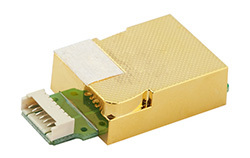 Esperanto
Esperanto
 Shqiptare
Shqiptare
 Euskara
Euskara
 Zulu
Zulu
 Latinus
Latinus
 Cymraeg
Cymraeg
 தமிழ்
தமிழ்
 Slovak
Slovak
 Slovak
Slovak
 Afrikaans
Afrikaans
CO2 Detector
Breathing tens of thousands of times a day, is it all fresh air?
Most people spend about 90% of their time indoors. The air we breathe indoors and our health are affected by many factors, including outdoor air quality, the movements of people indoors, and the design, construction, operation and maintenance of buildings.
Carbon dioxide is an important indicator to measure the freshness of indoor air. Human breathing will cause the indoor CO2 concentration to rise continuously and the oxygen content to decrease, making people drowsy. Rising carbon dioxide (CO2) levels and temperatures can increase outdoor airborne allergens that enter into indoor spaces. We generally use CO2 detectors to detect the indoor CO2 concentration to remind people or automatic equipment to ventilate, so as to ensure that we are breathing fresh air.
Effects of carbon dioxide on human health
Carbon dioxide is not a toxic gas and is harmless to the human body, but it has an impact on human health.
- When the indoor air carbon dioxide concentration is below 0.7‰, it is clean air, and the human body feels good;
- When the indoor air carbon dioxide concentration is 0.7‰~1‰, it is ordinary air, and individual sensitive people will feel bad smell;
- When the indoor air carbon dioxide concentration is 1‰~1.5‰, it is critical air, other symptoms of indoor air begin to deteriorate, and the human body begins to feel uncomfortable;
- When the indoor air carbon dioxide concentration is 1.5‰ to 2‰, it is light pollution, and if it exceeds 2‰, it is serious pollution;
- When the indoor air carbon dioxide concentration is 3‰ to 4‰, people's breathing deepens, and symptoms such as headache, tinnitus, and increased blood pressure appear;
- When it reaches more than 8‰, it will cause death by suffocation.
- When the carbon dioxide concentration is 350-450ppm, the same as the general outdoor environment;
- When the carbon dioxide concentration is 350-1000ppm, the air is fresh and the breathing is smooth;
- When the carbon dioxide concentration is 1001-2000ppm, people will feel mild hypoxia, feel the air is cloudy, can smell a little sour, and start to feel drowsy;
- When the carbon dioxide concentration is 2001-5000ppm, people will feel severe hypoxia, feel headache, drowsiness, sluggishness, inability to concentrate, rapid heartbeat, mild nausea;
- When the carbon dioxide concentration is above than 5000ppm, it may cause severe hypoxia, resulting in permanent brain damage, coma, and even death.
China's relevant requirements for indoor air quality stipulate that the indoor CO2 concentration is always required to be lower than 1000ppm, and the CO2 concentration in the atmosphere is usually maintained at about 400ppm.
Innovative technology setting the pace: make your CO2 Detector more accurate and efficient with Winsen.
 |
|
▲ MH-Z19C NDIR CO2 sensor |
The CO2 sensor generally used in the CO2 detector is generally an infrared gas sensor. The infrared CO2 sensor uses the principle of non-dispersive infrared (NDIR) to detect the CO2 present in the air. The Winsen MH-Z19C infrared CO2 sensor gas chamber is gold-plated, waterproof and anti-corrosion. It has the characteristics of good selectivity, no oxygen dependence, long life, anti-interference and so on.
RELATED PRODUCTS
MH-Z16 is an NDIR CO2 sensor. The dual-channel structure enables MH-Z16 to effectively eliminate the influence of environment and light source factors on itself. Long-term stability is better.
MH-Z19C NDIR infrared gas module is a common type, small size sensor, pins type or terminal type, using non-dispersive infrared (NDIR) principle to detect the existence of CO2 in the air, with good selectivity, non-oxygen dependent and long life. Built-in temperature compensation; and it has UART output and PWM output. It is developed by the tight integration of mature infrared absorbing gas detection technology, precision optical circuit design and superior circuit design.
The MH-Z19D carbon dioxide gas sensor uses the principle of non-dispersive infrared (NDIR) to detect the presence of CO2 in the air, and has two types of pins and terminals. It is a high-performance sensor produced by combining mature infrared absorption gas detection technology with precise optical path design and sophisticated circuit design.
NDIR CO2 Sensor Module MH-Z14B
MH-Z14B is a dual channel NDIR CO2 sensor. The appearance structure of this sensor is often one of the reasons for its selection. The MH-Z14B CO2 sensor starts at 0ppm, so it is very suitable for the agricultural field.
MH-V1512A NDIR infrared gas module is a common type, small size sensor, pins type or terminal type, using non-dispersive infrared (NDIR) principle to detect the existence of CO2 in the air, with good selectivity, non-oxygen dependent and long life. Built-in temperature compensation; and it has UART output and PWM output. It is developed by the tight integration of mature infrared absorbing gas detection technology, precision optical circuit design and superior circuit design.
MH-Z1311A carbon dioxide gas sensor (hereinafter referred to as the sensor) is a general-purpose, small-scale sensor that uses the principle of non-dispersive infrared (NDIR) to detect CO2 in the air. It has good selectivity, no oxygen dependence, and long life. , Built-in temperature compensation, digital output, easy to use. The sensor is a high-performance sensor made by closely combining mature infrared absorption gas detection technology with precise optical circuit design and sophisticated circuit design.
How to choose the right sensor for your project?
We have 17 sensor series, 200+ categories, and 300+ detection objects for gas detection. Such as CO, CO2, VOC, PM2.5, CH4, LPG and so on. In particular, we also have MEMS sensors. According to your industry application, gas principle, power consumption, accuracy, and range requirements, and we can select a specific model for you. You can also use the product filter below to choose a suitable product, or choose online serivce.
Related Links
The first six FAQs. Use the search bar above to reveal more!
What Are the Precautions for Manual Soldering of Semiconductor Sensors?
What is the Service Life of Mq Series Sensors?
Can the Catalytic Sensor Be Made into a Digital Display?









